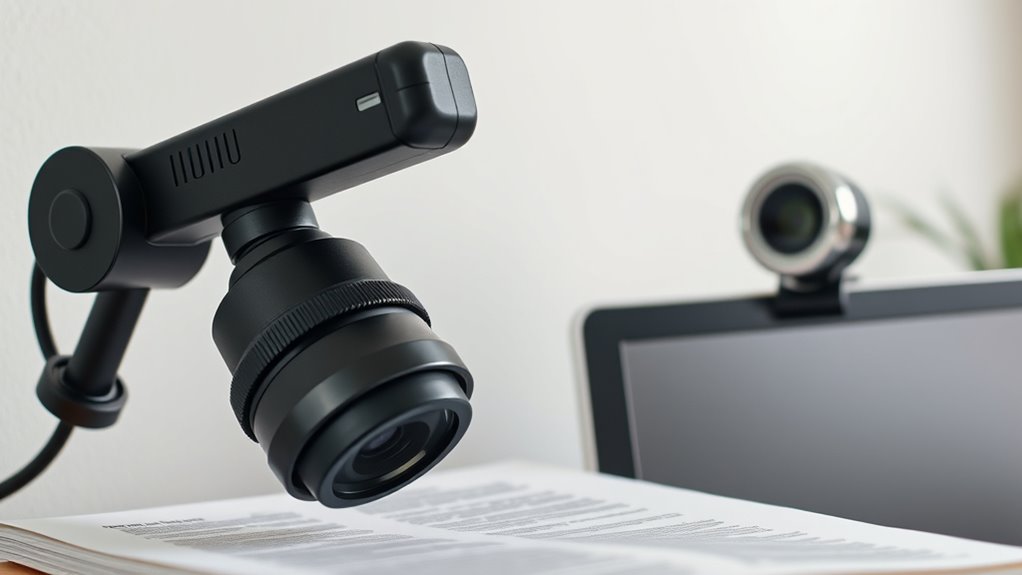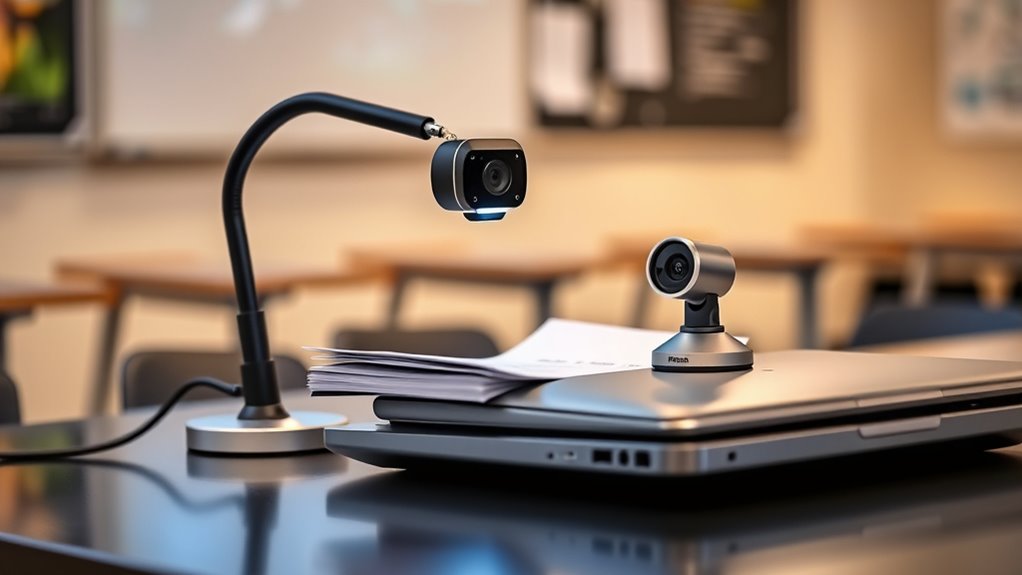If you need high-quality, detailed visuals for presentations, a document camera is your best choice because it offers higher resolution and adjustable focus for showing small objects or intricate diagrams. Webcams are more portable and great for quick video calls or casual meetings but lack the image clarity of document cameras. Understanding these differences helps you pick the right device, and if you keep exploring, you’ll discover even more features that suit your needs.
Key Takeaways
- Document cameras provide higher resolution and detailed image clarity, ideal for visualizing complex documents and objects.
- Webcams are more portable, lightweight, and easy to set up, suitable for quick video calls and remote communication.
- Document cameras are larger and less portable but excel in detailed presentations and technical demonstrations.
- Webcams generally have lower image quality but are sufficient for casual video conferencing and everyday use.
- The choice depends on whether detailed visualization or ease of mobility and quick setup is the priority.

When choosing between document cameras and webcams, understanding their differences can help you make the right decision for your needs. One of the first aspects to consider is image quality. Document cameras are designed to produce high-resolution images, making them ideal for displaying detailed documents, textbooks, or small objects clearly. They often feature adjustable focus and zoom capabilities, ensuring your audience sees every detail sharp and clear. Webcams, on the other hand, are primarily built for video communication and tend to have lower resolution compared to document cameras. While recent models offer decent image quality suitable for video calls, they generally don’t match the clarity and detail that document cameras provide. If you need to present complex diagrams or intricate artwork, a document camera’s superior image quality will serve you better.
Document cameras deliver high-resolution images ideal for detailed displays and intricate visuals.
Portability is another key difference that influences your choice. Webcams are typically compact, lightweight, and easy to connect to laptops or desktops via USB. Their small size makes them highly portable, so you can carry them around easily for different meetings or presentations. This convenience is especially valuable if you frequently switch between locations or need a simple setup. Document cameras tend to be larger and more cumbersome due to their built-in lenses, lights, and adjustable arms. While many models are portable enough to carry in a bag, they still require more space and setup time compared to webcams. If you need a device you can quickly set up and move around, a webcam’s portability might be more appealing.
Additionally, consider where you’ll use these devices. If your work involves detailed presentations, technical drawings, or showcasing small objects in real-time, a document camera’s ability to provide high-quality images and detailed visualization makes it a better fit. Conversely, if your focus is on video conferencing, casual meetings, or remote communication, a webcam’s ease of use and portability will likely meet your needs more efficiently.
Furthermore, the role of resolution and image clarity is essential, especially when detailed visualization is required. Both devices serve different purposes, and understanding these distinctions can help you select the right one for your specific tasks. Ultimately, your decision hinges on what’s more important for your activities: the enhanced image quality and detailed visualization offered by document cameras or the lightweight, portable nature of webcams. Both devices have their strengths, but understanding these core differences ensures you choose the right tool for your specific requirements.
Frequently Asked Questions
Are Document Cameras Compatible With All Operating Systems?
When considering operating system compatibility, you might wonder if a document camera works with your device. Most modern document cameras are compatible with common operating systems like Windows and macOS. However, you should check the software requirements to make sure of easy integration. Some models may have limited support or need specific drivers, so it’s crucial to verify compatibility beforehand to avoid any setup issues or performance problems.
What Is the Typical Lifespan of a Document Camera?
Remember when your old VCR lasted for decades? A modern document camera typically has a lifespan of 3 to 7 years, depending on durability concerns and maintenance requirements. You should handle it carefully, keep it clean, and avoid rough handling to extend its life. Like any tech, it’s not invincible, but with proper care, you can guarantee it stays functional longer and continues to serve your teaching needs effectively.
Can Webcams Be Used for High-Quality Document Scanning?
Webcams can be used for document scanning, but their effectiveness depends on the document resolution and image clarity they offer. You might get decent results for casual use, but they often lack the high resolution needed for detailed or professional scans. If you need sharp, clear images, a document camera is usually better because it’s designed specifically for capturing documents with superior image quality and clarity.
Do Document Cameras Require Special Software for Operation?
You might wonder if document cameras need special software for operation. Generally, they require specific software to handle features like capturing, zooming, and saving images, which can influence setup complexity. Some models are plug-and-play with minimal software needs, while others demand detailed installation. It is crucial to check the software requirements beforehand, as this impacts how easily you can set up and start using your document camera effectively.
How Do Lighting Conditions Affect Webcam Image Quality?
Lighting conditions greatly impact your webcam’s image quality. Poor lighting can cause grainy or blurry images, while good lighting enhances clarity. You should make lighting adjustments by adding more light sources or repositioning existing ones to reduce shadows and glare. Proper lighting ensures your webcam captures sharp, clear images, making your video calls look more professional and ensuring others see you at your best.
Conclusion
Think of document cameras and webcams as two explorers on a journey. The document camera is like a skilled cartographer, revealing intricate details of what’s before it, perfect for close-up teaching. The webcam, on the other hand, is a friendly guide, capturing your face and surroundings for real-time connection. Both serve essential roles, but knowing when to use each lets you navigate your digital landscape with confidence—transforming your lessons from ordinary to extraordinary.








